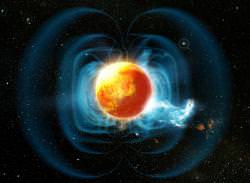The most common kinds of star in the Universe are M-dwarf stars. They’re normally cool (a mere 2,400 Kelvin), small (typically 8-10% the mass of the Sun) and quiet – really pretty boring for stars. But astronomers have found one that’s going against the grain. It has a strong magnetic field; greater even than our own Sun’s. And it has a huge hot spot that spans half of its surface.
Although the science about the star, TVLM513-46546, is pretty interesting, just think about the fact that researchers were actually able to detect it at all. Astronomers are able to measure a tiny star’s magnetic field, and locate a hot spot on its surface from 35 light-years away. Amazing stuff.
Okay, onto the discovery. It was made by combining data from several different observatories in different wavelengths: radio data from the Very Large Array, spectra from the Gemini North 8-metre telescope, ultraviolet from Swift, and X-rays from Chandra.
Over the course of their observations, the researchers learned that the star has steady radio emissions, but these are punctuated by minute-long firework displays coming from collisions of magnetic fields in the corona of the star. As the magnetic field lines connect and reconnect, enormous amounts of energy are released. These releases match soft X-ray emissions and X-ray flares.
Perhaps the most interesting is this enormous hot spot. The researchers were able to measure that half of the star is much brighter, and turns every two days with the rotation of the star. This is a total mystery to the researchers. “We still do not know why only half of the star is lit up in hydrogen and if this situation remains unchanged over days, weeks, years, or centuries,” remarked Edo Berger, a Carnegie-Princeton postdoctoral fellow.
The magnetic activity could mean that there’s unusual activity beneath the star’s surface. Or maybe there’s an undiscovered companion object interacting with the star. Nothing’s been seen so far, but it could be there.
The researchers are planning to study other examples of these ultracool M-dwarf stars and see if this is a common for many of them, or this star is just an anomaly.
Original Source: Gemini News Release


interesting. i have always thought that these little, long lived stars would be good candidates for planets possibly containing life. if more of them turn out to be like this little guy, i might have to rethink my belief.
Many dwarf stars often have large flares from time to time. Any lifeforms would have to survive these. Larger stars similiar to the sun seem more stable
Flare, seems most likely. A hot Jupiter in real close would be more interesting. Either way, great research work so far.